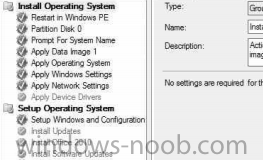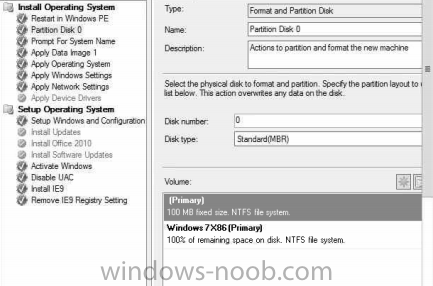-
Posts
1009 -
Joined
-
Last visited
-
Days Won
26
Everything posted by Rocket Man
-

Email Alert for software request
Rocket Man replied to Rocket Man's topic in Configuration Manager 2012
Coretech have some very good software.....currently using their shutdown tool for power management, will definitely try this out.. Cheers Rocket Man -
Recommend to use WMI query and if possible have individual driver packages for your models with the appropriate WMI query attached....I tried the auto apply drivers initially but found myself in similar situations, move to WMI query with individual packages and all good now!
-
Are you using a WMI query to determine the drivers that get installed?
-

Software packages taking a long time to install
Rocket Man replied to Leethenewf's topic in Configuration Manager 2012
Sounds a bit too long for 6 packages.......all my current production setups at present are using the package model as I did not have much experience with the application model until recently, but 2 hours for 6 packages definitely does not sound right. What are the packages? Are you downloading them 1st before running? In my larger Task sequences I could have as many as 20+ packages the larger ones been VS2010 and CS6 along with office 2010/2013 and usual packages such as java, adobes and others and to install the full task sequnece including OS/drivers from start to finish may take upto 50-60 mins max ....and some of my networks are only running at fast ethernet speeds. -
what you have to do is find the source of the uninstaller and then point your batch with your parameters as above to it OR use a run command line as outlined above. There are probably more methods but 1st you have to find the location of the uninstaller file be it an exe or an msi!
-
Very unfortunate It may be worth looking into having virtualized servers if it is feasible......considering it is a single domain controller you could have quite easily restored a virtual DC from backup this would save you all the hardship of having to rebuild a physical machine with a DC and having to get the network machines talking again to it.. Rocket
-
Well considering you could not get them to connect in the 1st place I think this is your only option and if anyway effecient it should only take you about half an hour max doing it manually(25 pcs??) And why would you want to migrate anything over from your old DC considering it became corrupt in the 1st place?
-
Just change the update schedule of all your collections to a more aggressive time(15mins or use delta discovery on the collections instead of full update).....this will automate it for you and speed up your slow moving software if you are continuously moving systems from OU to OU in AD!
-
Have you tried recreating your system installer again and a new build&capture TS? If not I would use a new set of media files(use winRAR to extract them from the iso) and start over! For a Hyper-v VM you should not need drivers. Also just double check the network access account by veryfying it to the location of your system installer directory when adding the account. Rocket Man
-
Why do you need to specify a computername in the uninstall(how will this mass uninstall??) I will give you an example of a situation i was in before. I implemented SCCM 2012 single site 360 odd PCs. All of them had eset AV on them. I wanted SCEP2010 on them but before I could do this I had to uninstall the ESET. The steps I took Went to the all programs folder on a machine that had the ESET on it. Found the uninstaller and opened file location. This pointed to "C:\Program Files\Eset\callmsi.exe" with an entry of {6E071DB4-85B9-45E1-A660-563804D08790}(not really this but this an example) So I devised a batch file as so "C:\Program Files\Eset\callmsi.exe" /uninstall {6E071DB4-85B9-45E1-A660-563804D08790} /quiet I created a package out of this batch file and deployed to all machines. This eventually removed the eset once all machines recieved the ConfiMgr Client and were able to recieve advertisements. Your MsiExec.exe /x{1E041DB4-A5B9-45E1-A660-563804Dxxxxx} /norestart /qb........how does it know where the location of this is to remove it?? You could a run command line task and point it to the location of the uninstaller with your parameters for example if your uninstaller msi was in the program files folder the run command line could be like this: c:\Program files\Program directory\uninstall.msi /uninstall {1E041DB4-A5B9-45E1-A660-563804D0xxxx} /norestart /qb
-
How do you mean they are unable to connect? What method are you using? Have you did the usual DNS flushes on the machines. In order to add an already existing domain machine to a new domain you need to 1st revert the machine back to a workgroup then add it to the new domain!! I could be fairly confident that your computers OU in Active directory users and computers is empty.......(So your new AD knows nothing about these machines as of yet until you re-add them to the domain) Make sure you know the local admin username and password 1st...if not then create one before you take it off the domain otherwise you will be locked out of the machine and you will have to rebuild!!
-

Office 2013 Pro (OCT)
Rocket Man replied to Rocket Man's question in Deploy software, applications and drivers
It works fine using all other components with OCT just the configure shortcuts component is buggy.......I use the oct the same way as office 2010 bar configuring shortcuts and i have another package with all the office shortcuts in it that I want to copy to the public desktop and to do this i use a batch file, working so far, but would rather have the OCT do it for me! -

Sync problem with SUP and WSUS using the guides.
Rocket Man replied to midiman's topic in Configuration Manager 2012
When you enable WSUS on server 2012 it creates it a custom website for it, not the default one!! When configuring SUP in SCCM point it to the custom website not the default! -

Sync problem with SUP and WSUS using the guides.
Rocket Man replied to midiman's topic in Configuration Manager 2012
When configuring your SUP through SCCM did you specify it to use the custom website port 8530 and not the default iis website which is used for SCCM? -

Question on "best" topology design
Rocket Man replied to HaikoH's topic in Configuration Manager 2012
1 Primary and remote DPs at each of the other locations... -
Move the apply data image1 directly above the apply OS task...in the partiotion task you will see 2 partitions the 1st one been very small approx 100mb this is the apply data image1 thus the reason as to why you have to move it above the apply OS task, also in partition task select the second partition and edit it make it install on 100% of the rest of the disk(this is your C drive) and also name the partition if you like!! I have some images that have this apply data image after I have captured from a VM, and when I create an OS image and TS out of it I have the same tasks(apply data image 1 and apply OS), i do the above and it works for me, no reason as to why it should not work for you!! Remove the capture files and remove the capture windows settings of the task sequence and see how it go's.. This image is same as your TS except i moved the apply data image above the apply OS This one shows the the 100 mb partition(this is the apply data image and by default is above the main primary partition thus the reason as to why you have to move it above the apply OS)
-
What program are you deploying and what is the syntax of your script? If it is an msiexec /i script then try this msiexec /i "%~dp0program.msi" /parameters Try it with the quotes and without the quotes..
-
It should do this automatically hence the query rule....give it time, run update membership on collection or run system discovery from discovery methods if in a panic to see it happen.. Rocket
-
Hi Peter I do have SQL 2012 Enterprise installed with CU3 at present, it was also this build with the initial attempt with the 2 instances. I do not think that it was running at 100% I am fairly sure I would have noticed this, but I do remember it raising slightly now and again while sitting idle doing nothing, 16-30% at times. This could not be normal as it is idle and only 1-2 testing machines for deployments etc.. I have a few production environments and one of them is supporting approx 20000 systems across several remote locations and the CPU usage on Hyper-V with this machine(SQL2k8R2 SP1 CU6 and SCCM2012) never raises at all!! But for now with the 1 instance for all DBs on SQL 2012 Ent CU3 seems to be running away much better than having 2 seperate instances!
-
Hi Anyweb Quick query on the ADR(just want to make sure as I am currently in the process of a Primary with 30 remote DPs and am going to soon introduce ADRs) In my enviornment I am constantly imaging machines on a weekly basis, so I am just wondering does this update package hold onto all previous months updates without expiring them? As I need a newly built machine to get this months updates from the ADR but I also want them to get say the 2,3,4 previous monthly patches also.....does it do this? I had been doing it different with my other sites....in the ADR configuration I currently have just product ID and also superseded NO component and evaluation of every 3rd thursday(just to give time if there are any problematic updates to remove them before they are deployed). IT seems to be working so far so good but I also just added these to an existing software update group(same as FEP ADR) without disabling the ADR and creating an identical one and pointing it to the initial SUG... Could this cause problems other than not been able to see the compliance? Thanks Rocket Man
-
Hi Peter The instance for WSUS was created with same permissions as SCCM instance........there is not much on the web about the error code, but the weird thing is it is still sycronizing regardless. Just to confirm my initial thoughts, I blew this install away and setup another new test lab, nothing different this time bar having all databases on the default instance. Set up my SUP and what do you know all nice green ticks on SUP site component with no errors. So my question now is........is it better to have all DBs on the one SQL 2012 CU3 instance with SCCM2012 SP1?? I am Curious as I have a few production sites with SCCM 2012 non SP1 on SQL 2K8R2 SP1 CU6 with seperate instances for ConfigMgr and WSUS DBs and have had no errors on these.
-
Hoping there is an easy solution to this? Anyone any idea on how to set up an email alert if a user requests a specific piece of software from the APP catalog that requires a request approval. I only need this working one way, so if a user requests the software i get an email alert that there is a request in for software. Or to achieve this does it require the likes of orchestrator to be implemented? Thanks Rocket Man
-
Are you distributing your TS to DPs? OR Have you individually distributed all packages attached to TS to your DPs? If it is the 1st then after you deleted the first TS then this would have also removed all content attached to it from DP also. You may have to distribute all attached packages again out to the DPs.





